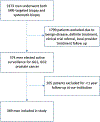Magnetic Resonance Imaging-Targeted and Systematic Biopsy for Detection of Grade Progression in Patients on Active Surveillance for Prostate Cancer
- PMID: 33356479
- PMCID: PMC9677228
- DOI: 10.1097/JU.0000000000001547
Magnetic Resonance Imaging-Targeted and Systematic Biopsy for Detection of Grade Progression in Patients on Active Surveillance for Prostate Cancer
Abstract
Purpose: Active surveillance for patients with low and intermediate risk prostate cancers is becoming a more utilized option in recent years. However, the use of magnetic resonance imaging and imaging-targeted biopsy for monitoring grade progression has been poorly studied in this population. We aim to define the utility of magnetic resonance imaging-targeted biopsy and systematic biopsy in an active surveillance population.
Materials and methods: Between July 2007 and January 2020, patients with diagnosed prostate cancer who elected active surveillance were monitored with prostate magnetic resonance imaging, imaging-targeted biopsy and standard systematic biopsy. Patients were eligible for surveillance if diagnosed with any volume Gleason grade 1 disease and select Gleason grade 2 disease. Grade progression (Gleason grade 1 to ≥2 disease and Gleason grade 2 to ≥3 disease) for each biopsy modality was measured at 2 years, 4 years and 6+ years.
Results: In total, 369 patients had both magnetic resonance imaging-targeted and systematic biopsy and were surveilled for at least 1 year. At 2 years, systematic biopsy, magnetic resonance imaging-targeted biopsy and combined biopsy (systematic+imaging-targeted) detected grade progression in 44 patients (15.9%), 73 patients (26.4%) and 90 patients (32.5%), respectively. Magnetic resonance imaging-targeted biopsy detected more cancer grade progression compared to systematic biopsy in both the low and intermediate risk populations (p <0.001). Of all 90 grade progressions at the 2-year time point 46 (51.1%) were found by magnetic resonance imaging-targeted biopsy alone and missed by systematic biopsy.
Conclusions: Magnetic resonance imaging-targeted biopsy detected significantly more grade progressions in our active surveillance cohort compared to systematic biopsy at 2 years. Our results provide compelling evidence that prostate magnetic resonance imaging and imaging-targeted biopsy should be included in contemporary active surveillance protocols.
Keywords: multiparametric magnetic resonance imaging; prostatic neoplasms; watchful waiting.
Conflict of interest statement
Financial interest and/or other relationship with NVIDIA and NIH (which has cooperative research and development agreements with Philips, Celsion Corp., Boston Scientific, Siemens and Exact Robotics, and MTA support with Exact Imaging, Canon Medical, QT Imaging and Angiodynamics).
Figures



Comment in
-
Editorial Comment.J Urol. 2021 May;205(5):1359. doi: 10.1097/JU.0000000000001547.02. Epub 2021 Mar 11. J Urol. 2021. PMID: 33705226 No abstract available.
-
Editorial Comment.J Urol. 2021 May;205(5):1358-1359. doi: 10.1097/JU.0000000000001547.01. Epub 2021 Mar 11. J Urol. 2021. PMID: 33705227 No abstract available.
References
-
- Hamdy FC, Donovan JL, Lane JA et al.: 10-Year outcomes after monitoring, surgery, or radiotherapy for localized prostate cancer. N Engl J Med 2016; 375: 1415. - PubMed
-
- Bill-Axelson A, Holmberg L, Garmo H et al.: Radical prostatectomy or watchful waiting in prostate cancer—29-year follow-up. N Engl J Med 2018; 379: 2319. - PubMed
-
- Klotz L, Vesprini D, Sethukavalan P et al.: Long-term follow-up of a large active surveillance cohort of patients with prostate cancer. J Clin Oncol 2015; 33: 272. - PubMed
-
- Klotz L: Active surveillance with selective delayed intervention: using natural history to guide treatment in good risk prostate cancer. J Urol 2004; 172: S48. - PubMed
Publication types
MeSH terms
Grants and funding
LinkOut - more resources
Full Text Sources
Medical

